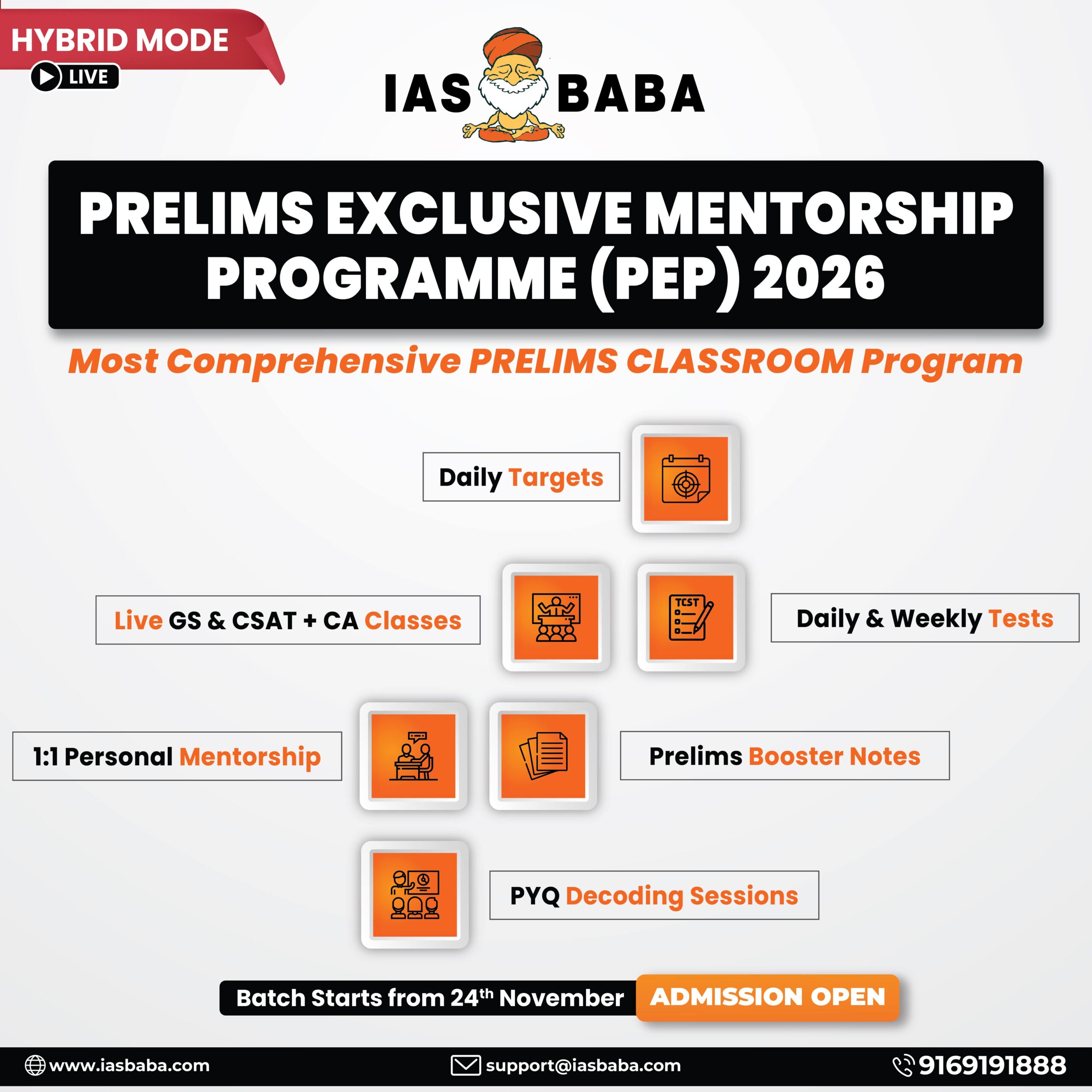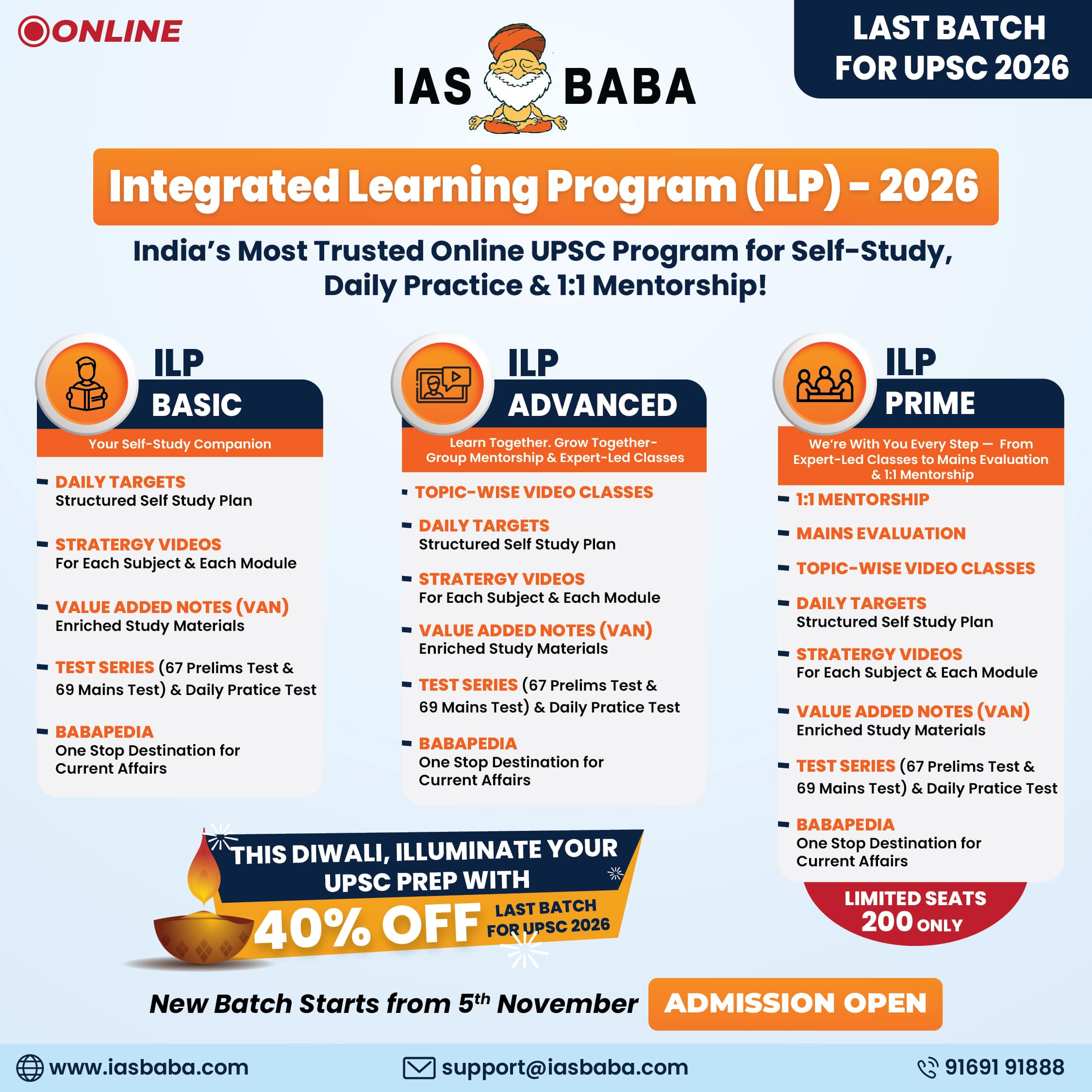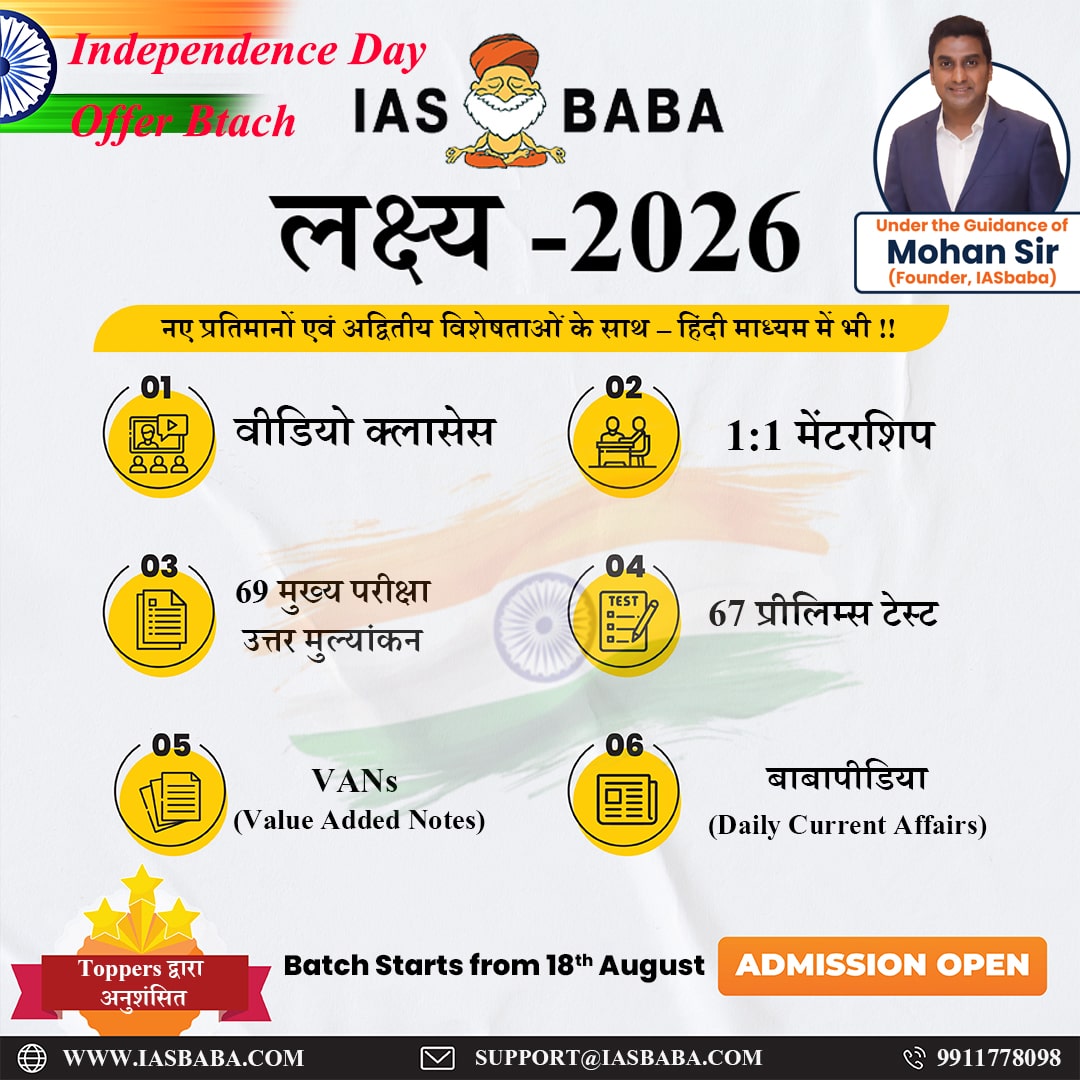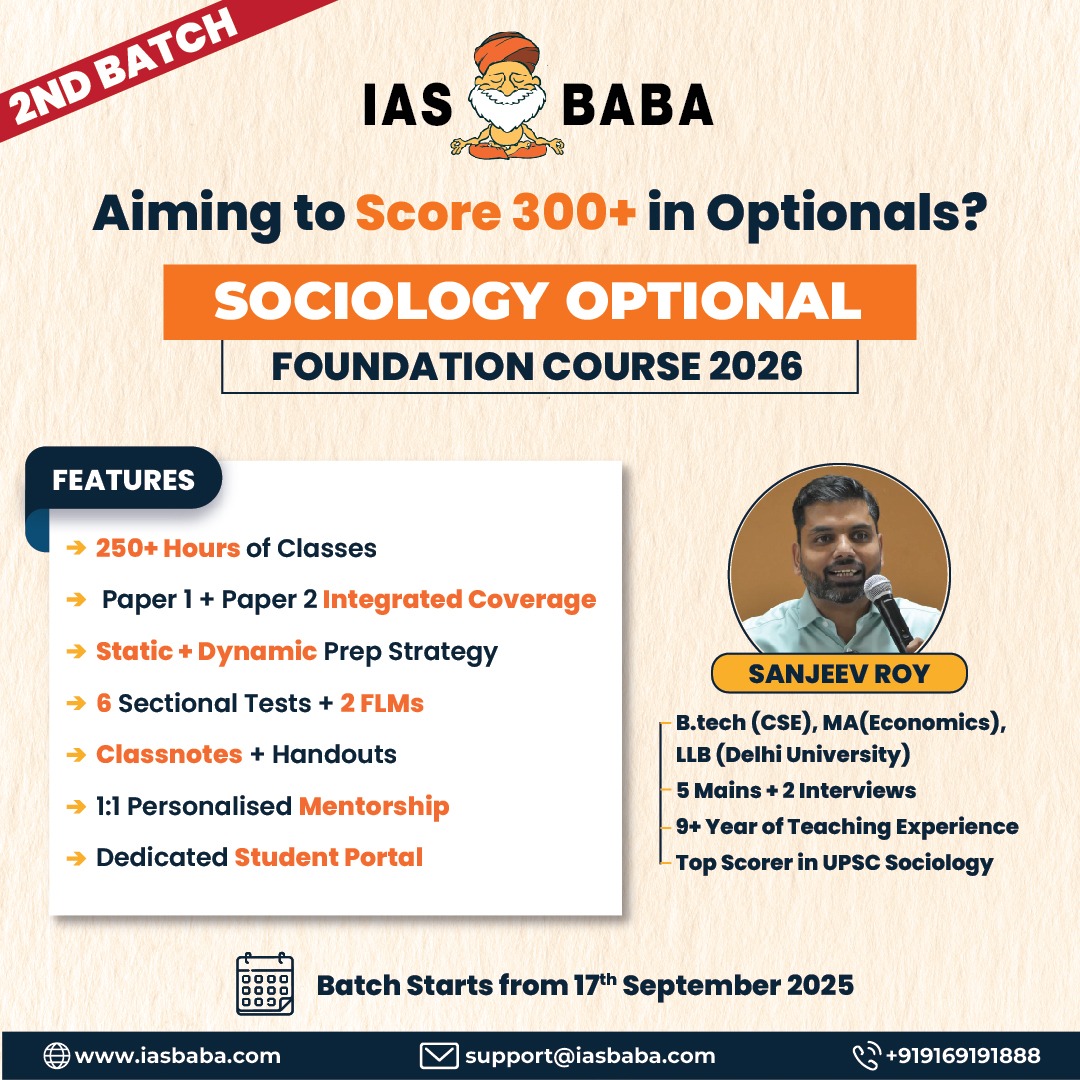IASbaba's Daily Current Affairs Analysis
Archives
(PRELIMS & MAINS Focus)
Category: ENVIRONMENT
Context: Kerala and Tamil Nadu will jointly carry out a Nilgiri Tahr census from April 24 to 27. The survey will span 89 census blocks in Kerala and 176 blocks in Tamil Nadu over the four-day period.
Decoding the context: Kerala Forest Minister A.K. Sase announced the initiative, stating that the synchronised survey of the mountain ungulate is being conducted to commemorate the 50th anniversary of the establishment of Eravikulam National Park.
Learning Corner:
- Scientific Name: Nilgiritragus hylocrius.
- Common Name: Nilgiri Tahr (locally called Varayadu in Tamil/Malayalam).
- Taxonomy: Belongs to the Bovidae family (related to goats and antelopes), it is the only mountain ungulate species in southern India.
- Status: Classified as Endangered on the IUCN Red List due to habitat loss and population decline.
- Habitat: Found exclusively in the Western Ghats, primarily in Tamil Nadu and Kerala, at elevations between 1,200 and 2,600 meters.
- Key Locations:
- Tamil Nadu: Mukurthi National Park, and Anamalai Hills.
- Kerala: Eravikulam National Park, Silent Valley National Park and Parambikulam Tiger Reserve.
- Population: Estimated at around 3,000 individuals (as of recent surveys), with Eravikulam hosting the largest population (~700-800).
- Geographical Significance: Thrives in montane grasslands and shola forests, a unique ecosystem of the Western Ghats.
Physical and Behavioral Characteristics
- Appearance: Males are larger, with curved horns, darker coats (greyish-brown), and a distinctive saddle-like patch after maturity. Females are smaller, with lighter coats and shorter horns.
- Adaptations: Agile climbers suited to steep, rocky terrains; grazes on grasses and herbs in montane ecosystems.
- Behavior: Lives in small herds (10-20 individuals), with males often solitary except during mating season (monsoon, June-August).
Ecological Importance
- Role in Ecosystem: As a herbivore, it maintains grassland ecosystems by grazing, preventing shrub overgrowth and supporting shola forest dynamics.
- Indicator Species: Its presence reflects the health of high-altitude ecosystems in the Western Ghats, sensitive to climate change and habitat disturbance.
Conservation Efforts
- Project Nilgiri Tahr (2023): Launched by the Tamil Nadu government to protect the species, declared the State Animal of Tamil Nadu. Aims to map habitats, boost populations, and raise awareness.
- Operation Tahr: Efforts to relocate small populations to new habitats (e.g., Mukurthi) to reduce overcrowding risks.
- International Frameworks: Covered under CITES Appendix I, restricting trade in its parts.
Source : The Hindu
Category: ENVIRONMENT
Context: According to a new study published in Nature Climate Change, the increasing ferocity of wildfires means that more than 30 % of Arctic Boreal Zone has now stopped capturing carbon and is instead releasing it.
Decoding the context: The consequences of these changes creates a dangerous feedback loop. According to the study, as wildfires become more common and more intense, they burn through the natural carbon reservoirs that have historically helped regulate the earth’s climate. The carbon released from these fires further fuels global warming, which in turn creates conditions for more frequent and intense wildfires.
Learning Corner:
- Location: The ABZ spans the high-latitude Northern Hemisphere, roughly above 50°N, encompassing parts of the Arctic and sub-Arctic (boreal) regions. It includes:
- Countries: Canada, Russia, United States (Alaska), Nordic countries (Norway, Sweden, Finland), and Greenland (Denmark).
- Area: Covers approximately 26 million square kilometers, including boreal forests (taiga), treeless tundra, wetlands, and permafrost regions.
Physiography:
- Boreal Forests (Taiga): World’s largest terrestrial biome, dominated by coniferous trees (pines, spruces, firs).
- Tundra: Treeless areas with low shrubs, grasses, and permafrost (permanently frozen soil).
- Transition Zone: Gradual shift from forested taiga to barren tundra.
- Climate: Cold, subarctic, with long winters (-50°C to 0°C) and short summers (0°C to 20°C). Annual precipitation is low (15-100 cm), often as snow.
Ecological Significance
- Flora: Cold-tolerant species like conifers, mosses, lichens, and tundra grasses.
- Fauna: Polar bears, Arctic foxes, caribou, migratory birds (e.g., ducks), and fish in Arctic rivers. The ABZ is a breeding ground for over half of North America’s migratory birds.
- Historically, the ABZ acted as a carbon sink, storing vast amounts of carbon dioxide (CO₂) in permafrost soils (1,460-1,600 petagrams of organic carbon, nearly twice the atmospheric carbon).
- Recent studies (e.g., Nature Climate Change, 2025) indicate that 34-40% of the ABZ has become a carbon source, releasing more CO₂ than it absorbs due to permafrost thaw, wildfires, and microbial activity.
- Arctic Amplification: The ABZ warms 2.5-4 times faster than the global average due to reduced sea ice (albedo effect) and greenhouse gas emissions.
Source : The Hindu
Category: ART & CULTURE
Context: India celebrated Mahavir Jayanti, a day of deep spiritual significance and profound peace, commemorating the birth of Lord Mahavir, the 24th Tirthankara of Jainism.
Decoding the context: This year, the spirit of Mahavir Jayanti was powerfully invoked through the inauguration of Navkar Mahamantra Divas by Prime Minister Narendra Modi on April 9. The Navkar Mantra, central to Jain prayer, is more than a collection of sacred syllables, it is a rhythmic flow of energy, stability, and light.
Learning Corner:
- Born as Vardhamana in 599 BCE (traditional date, though some sources suggest 615 BCE) in Kundagrama (modern-day Vaishali, Bihar).
- Belonged to the Kshatriya clan of the Ikshvaku dynasty, son of King Siddhartha and Queen Trishala of the Licchavi republic.
- He was spiritual successor of the 23rd Tirthankara Parshvanatha. Title Mahavir (“Great Hero”) reflects his spiritual conquest over worldly attachments.
- At age 30, after his parents’ death, he renounced royal life to pursue asceticism, seeking liberation from the cycle of birth and death (samsara).
- Underwent 12 years of intense meditation, austerity, and penance, achieving Kevala Jnana (omniscience) at 42 under a sal tree in Jrimbhikagrama (Bihar).
Philosophical Contributions/ Core Teachings:
- Five Mahavratas (Great Vows) for ascetics (also guiding laypersons):
- Ahimsa (Non-violence): Absolute respect for all life forms, influencing diet (strict vegetarianism) and behavior.
- Satya (Truthfulness): Commitment to honesty in thought, word, and deed.
- Asteya (Non-stealing): Respecting others’ property and rights.
- Brahmacharya (Celibacy): Chastity for monks; fidelity for householders.
- Aparigraha (Non-possessiveness): Detachment from material and emotional attachments.
- Three Jewels (Triratna):
- Right Faith (Samyak Darshan): Belief in Jain principles.
- Right Knowledge (Samyak Jnana): Understanding the nature of reality.
- Right Conduct (Samyak Charitra): Living ethically per the vows.
- Karma: Emphasized that actions (good or bad) bind the soul to samsara, and liberation (moksha) requires shedding karmic burdens through austerity.
- Anekantavada: Doctrine of “many-sidedness,” promoting tolerance by acknowledging multiple perspectives of truth.
- Syadvada: Logical extension of Anekantavada, suggesting conditional truths (e.g., “in some ways, it is”).
Role in Jainism
- 24th Tirthankara: Mahavir is considered the last of the 24 spiritual teachers (Tirthankaras) in Jainism, who revitalized the faith rather than founding it (Rishabhanatha, the 1st Tirthankara, is credited as the founder).
- Reformer: Systematized Jain doctrines, organized the monastic community (sangha), and simplified teachings for wider acceptance.
- Fourfold Order (Chaturvidha Sangha): Established a structured community of: Monks (Sadhus), Nuns (Sadhvis), Laymen (Shravakas), Laywomen (Shravikas).
- Spread of Jainism: Traveled extensively across Magadha, Kosala, and Anga, gaining followers among kings (e.g., Bimbisara, Ajatashatru) and commoners.
- Social Reforms: Advocated equality, rejecting caste hierarchies, and emphasized individual effort for salvation, challenging Vedic rituals. Encouraged women in spiritual pursuits; the Jain sangha had a significant number of nuns.
- Jain Texts: Mahavir’s teachings were initially oral, later compiled by his disciples into Agamas (canonical texts). The Jain Agamas and their commentaries were composed mainly in Ardhamagadhi Prakrit as well as in Maharashtri Prakrit. Key Scriptures :
- Acharanga Sutra: On monastic conduct.
- Sutra Kritanga: On philosophical debates.
- Kalpa Sutra: Biographies of Tirthankaras.
Source : PIB
Category: NATIONAL
Context: Phase 2 of the “Niveshak Didi” initiative was launched recently.
Decoding the context: During Phase 1, more than 55,000 beneficiaries participated in IPPB Financial Literacy Camps across India, with approx. 60% female beneficiaries mostly in the youth & economically active age group.
Learning Corner:
- Phase 1: Initiated in 2022 by the India Post Payments Bank (IPPB) in collaboration with the Investor Education and Protection Fund Authority (IEPFA) under the Ministry of Corporate Affairs (MCA), with support from the Department of Posts, Ministry of Communications.
- Phase 2 (April 2025): Expanded to deepen outreach, with a Memorandum of Agreement (MoA) signed between IEPFA and India Post Payments Bank (IPPB) to train more women and conduct additional camps.
- Core Ideology: “By the women, for the women,” recognizing that rural women feel more comfortable discussing financial matters with other women, fostering trust and engagement.
- Objective: To empower rural and semi-urban women with financial literacy, enabling them to make informed decisions about savings, investments, digital banking, and fraud prevention.
Key Features
- Women-Led Model:
- Trains women postal workers and community leaders as “Niveshak Didis” (female educators) to deliver financial education in local languages and culturally relatable ways.
- Leverages the trust and social connect of women like female postwomen (dakiyas) to bridge literacy gaps.
- Focus Areas:
- Banking Products: Understanding savings accounts, fixed deposits, and loans.
- Digital Banking: Promoting UPI, mobile banking, and paperless transactions via IPPB’s platforms.
- Investment Awareness: Educating on safe investments and risks of unregulated schemes.
- Fraud Prevention: Teaching how to identify financial scams and protect personal information.
- Financial Planning: Encouraging responsible money management for household and future security.
- Delivery Methods:
- Village-level camps, door-to-door outreach, and interactive sessions.
- Use of IPPB’s network (1.65 lakh post offices, 3 lakh postal employees) for grassroots penetration.
Source : PIB
Category: ECONOMY
Context: The Department of Financial Services (DFS) has notified the amalgamation of 26 Regional Rural Banks (RRBs) under the “One State, One RRB” principle. This is the fourth phase of the RRB consolidation process.
Decoding the context: 26 RRBs across 10 states and one Union Territory have been merged, focusing on enhancing scale, efficiency, and cost rationalisation. Currently, 43 RRBs operate across 26 states and two Union Territories. Post-amalgamation, there will be 28 RRBs covering 700 districts with more than 22,000 branches. Around 92 percent of these branches are located in rural and semi-urban areas.
Learning Corner:
- RRBs were created on October 2, 1975, under the Regional Rural Banks Act, 1976, following recommendations of the Narasimham Working Group (1975) to address credit gaps in rural areas left by commercial banks and cooperatives.
- Objective: To provide affordable banking and credit facilities to small farmers, agricultural laborers, artisans, and rural entrepreneurs, fostering rural economic development.
- First RRB: Prathama Bank, established in Moradabad, Uttar Pradesh, sponsored by Syndicate Bank.
- RRBs are jointly owned by: Central Government: 50%, Sponsor Bank (usually a public sector bank): 35%, State Government: 15%.
- Sponsorship: Each RRB is linked to a sponsor bank (e.g., State Bank of India, Punjab National Bank) for operational and managerial support. Post- the present consolidation, the largest RRB in a state becomes the transferee bank, with its sponsor bank overseeing the amalgamated entity.
- RRBs are mandated to follow Priority Sector Lending (PSL) targets. As of 2025, the PSL target for RRBs is 75% of ANBC, significantly higher than the 40% required for other commercial banks, reflecting their primary role in rural and agricultural credit.
Significance of “One State, One RRB” Amalgamation
- Scale Efficiency: Larger RRBs reduce operational overlap, streamline administration, and lower costs.
- Financial Stability: Mergers enhance capital base (deposits: ₹6.6 lakh crore; advances: ₹4.7 lakh crore as of March 2024), reducing reliance on government recapitalization.
- Technology Adoption: Consolidated entities can invest in modern banking tech (e.g., core banking systems), competing with private banks and small finance banks.
- Uniform Branding: New names reflecting state identity (e.g., Bihar Gramin Bank) strengthen trust and regional connect.
Source : Newsonair
Practice MCQs
Q1.
With reference to Lord Mahavir and Jainism, consider the following statements:
- Lord Mahavir was the founder of Jainism and the first Tirthankara in the Jain tradition.
- The concept of Anekantavada, attributed to Mahavir, promotes the idea of multiple perspectives or truths.
- The language used by Lord Mahavir for delivering his teachings was Sanskrit.
- The Acharanga Sutra is one of the oldest Jain texts and deals with the conduct of monks.
Which of the statements given above is/are correct?
A.2 and 4 only
B. 1, 2 and 3 only
C. 1 and 3 only
D. 2, 3 and 4 only
Q2.
Which of the following statements about the “Niveshak Didi” initiative is/are correct?
- It is a financial literacy program launched by the Reserve Bank of India.
- The initiative trains women postal workers to act as financial educators in rural areas.
- The program aims to promote financial literacy among urban youth.
Select the correct answer using the code below:
- 1 and 2 only
- 2 only
- 1 and 3 only
- 2 and 3 only
Q3.
With reference to Regional Rural Banks (RRBs) in India, consider the following statements:
- RRBs are required to maintain Statutory Liquidity Ratio (SLR) norms as mandated by the RBI.
- RRBs are exempt from maintaining the Capital to Risk-weighted Assets Ratio (CRAR).
- RRBs are regulated by National Bank for Agriculture and Rural Development (NABARD) alone.
- RRBs are required to maintain the Statutory Liquidity Ratio (SLR) similar to Scheduled Commercial Banks.
Which of the statements given above are correct?
A. 1 and 2 only
B. 1 and 4 only
C. 1, 3 and 4 only
D. 2 and 3 only
Comment the answers to the above questions in the comment section below!!
ANSWERS FOR ’ Today’s – Daily Practice MCQs’ will be updated along with tomorrow’s Daily Current Affairs
ANSWERS FOR 10th April – Daily Practice MCQs
Q.1) – b
Q.2) – b
Q.3) – a













